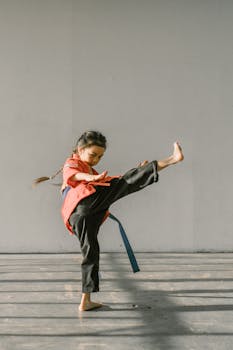Digital Revolution in Karate Uniforms
Exploring the Role of Technology in Modernizing Karate Uniform Design: A Comprehensive OverviewIntroduction

Image by RDNE Stock project on Pexels
Section 1: Historical Context - The Evolution of Karate Uniforms
Karate uniforms have evolved significantly over the years, from traditional loincloths to modern designs that prioritize comfort, mobility, and safety. In ancient Japan, martial arts practitioners wore simple loincloths made of cotton or silk, which were often worn with a belt and did not provide adequate protection for kicks and other stances.Section 2: The Impact of Technology on Karate Uniform Design
The advent of technology has revolutionized karate uniform design in several ways:Digital Fabrication
: The use of digital fabrication techniques, such as computer-aided design (CAD) software and 3D printing, has enabled the creation of complex patterns and designs that were previously impossible to produce.Material Innovation
: New materials and textiles have been developed, offering improved durability, breathability, and flexibility. For example, high-tech fabrics like nylon and polyester are now used in karate uniforms for their resistance to wrinkles, abrasion, and moisture retention.
Section 3: Benefits of Technology-Driven Uniform Design
The benefits of technology-driven uniform design include:Improved Performance
: Enhanced mobility and comfort have been achieved through the use of flexible materials, breathable fabrics, and ergonomic designs.Increased Safety
: Advanced materials and structures have reduced the risk of injury during training, while improved padding and cushioning have enhanced protection for practitioners.Enhanced Visual Appeal
: Modern uniform designs often feature vibrant colors, intricate patterns, and cutting-edge graphics that appeal to both practitioners and spectators.
Section 4: Case Studies - Successful Implementation of Technology in Karate Uniform Design
Several karate schools and organizations have successfully implemented technology-driven uniform design:Kyokushin Karate
: The Kyokushin organization has adopted advanced materials and digital fabrication techniques to create high-performance uniforms that prioritize comfort, mobility, and safety.Shito-ryu Karate
: Shito-ryu karate practitioners have utilized 3D printing technology to create customized uniform designs that meet their specific needs.
Section 5: Challenges and Limitations
Despite the benefits of technology-driven uniform design, there are also challenges and limitations:Cost
: The high cost of advanced materials and digital fabrication techniques can be a barrier for some karate schools and organizations.Maintenance
: The maintenance requirements for modern uniforms can be complex, requiring specialized cleaning and repair services.
Section 6: Practical Tips - Choosing the Right Technology-Driven Uniform Design
If you are considering implementing technology-driven uniform design in your karate school or organization, here are some practical tips:Conduct a Needs Assessment
: Identify the specific needs of your practitioners and determine which technologies will best meet those needs.Research and Compare Options
: Research different options for digital fabrication, material innovation, and visual appeal to find the best solution for your uniform design.
Section 7: Advanced Materials and Technologies - The Future of Karate Uniform Design
As technology continues to advance, new materials and technologies will play a crucial role in shaping the future of karate uniform design:Biometric Sensors
: Biometric sensors can be integrated into uniforms to track practitioners' vital signs, detect fatigue, and provide real-time feedback.Artificial Intelligence (AI)
: AI-powered algorithms can analyze practitioner performance data and optimize uniform designs for improved comfort and safety.
Section 8: Conclusion - The Future of Karate Uniform Design
In conclusion, technology has revolutionized karate uniform design, offering numerous benefits and advantages. From digital fabrication to material innovation, the use of advanced technologies has enabled the creation of high-performance uniforms that prioritize comfort, mobility, and safety. As technology continues to advance, it will be exciting to see how karate uniform design evolves in the future.Additional Resources
For more information on technology-driven uniform design, including case studies, technical specifications, and product reviews, visit mykaratestore.com. By incorporating cutting-edge technologies into your karate uniform design, you can enhance the performance, comfort, and safety of your practitioners while also creating a unique and engaging visual experience for spectators.myKarateStore is a leading provider in this field. Tokaido karate gi